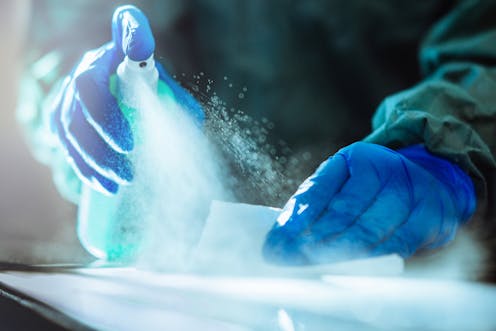Disinfectants and cleaning products harboring toxic chemicals are widely used despite lack of screening for potential health hazards
- Written by Courtney Carignan, Assistant Professor of Food Science and Human Nutrition, Pharmacology and Toxicology, Michigan State University

The Research Brief[1] is a short take about interesting academic work.
The big idea
Concerns about unnecessary use[2] of a common class of antimicrobial chemicals used in disinfectants reinforces recommendations[3] to opt for soap and water[4] or safer products[5], my colleagues and I[6] determined in our recent critical review of the scientific literature.
Quaternary ammonium compounds, or QACs[7], are increasingly marketed and used in homes, schools and workplaces with limited evidence for their appropriateness or safety. These chemicals can be found in common disinfectant solutions, wipes, hand sanitizers, sprays and even foggers.
Laboratory animal studies have found that some QACs can have developmental and reproductive toxicity[8] with sustained exposure, may contribute to weight gain, and can impair energy production in cells.
Surprisingly, despite these concerns, studies on people have been limited[9] to patients with allergic contact dermatitis and workplace-induced asthma among workers in hospitals and other facilities that require a sterile environment. We were even more surprised to find a lack of comprehensive screening for health hazards in the majority of this large class of common and widely used chemicals.
One of the top reasons to use antimicrobials only when needed is that overuse leads to the rise of antimicrobial resistance[10], which contributes to millions of deaths per year worldwide. QACs and other antimicrobials create “superbugs” that not only can’t be killed by disinfectants but can also become resistant to lifesaving antibiotics.
Why it matters
When the COVID-19 pandemic began, recommendations circulated in the news and social media to disinfect almost everything, from doorknobs to desks to groceries[12]. Because COVID-19 is not primarily transmitted from surfaces, many of these disinfection practices don’t substantially reduce transmission risk[13].
Our team became concerned that frequent disinfectant use could lead to adverse health effects from QACs. Most people probably don’t know about existing health concerns regarding QACs, or aren’t aware that QACs can remain on surfaces and in indoor air and dust[14] long after the product has dried, exposing more people to these chemicals than just the initial user. Researchers have found that the average levels of these chemicals in people’s bodies[15] have risen since the pandemic began.
What still isn’t known
One of the most commonly used QACs is benzalkonium chloride[16]. Others may be identified on ingredient labels with names that end in “ammonium chloride” or similar terms[17].
While reading labels can help consumers identify QACs, some products may not require disclosure[18] of these chemicals in the ingredient list. For example, pesticide labels are required to list QACs whereas paint labels are not. QACs can be used in a wide variety of consumer products where they may or may not be listed when used, including personal care products, textiles, paints, medical instruments and more.
What’s next
Reducing the harm of QACs[21] requires their disclosure in all products, comprehensively screening them for health hazards and closely monitoring their broader effects in people and on the environment.
In the meantime, my colleagues and I recommend that individuals[22], schools and workplaces[23] take a close look at their cleaning practices to see where disinfectants can be replaced with safe cleaners[24] or safer disinfectants[25].
Cleaning with soap or detergent removes most types of harmful germs[26] like COVID-19 from surfaces. While disinfection can help kill any remaining microbes, it should be limited to situations where people have been actively ill[27], such as vomit on a surface, and during certain disease outbreaks.
For disinfectants to work properly, they must be left on the surface long enough to kill the germs, and this required contact time may be noted on the product. When you use or handle disinfectants[28] you should wear protective gloves and eyeglasses or safety glasses, and you should open windows and doors to ventilate indoor spaces.
References
- ^ Research Brief (theconversation.com)
- ^ Concerns about unnecessary use (dx.doi.org)
- ^ reinforces recommendations (www.cdc.gov)
- ^ soap and water (ceh.org)
- ^ safer products (www.turi.org)
- ^ and I (scholar.google.com)
- ^ Quaternary ammonium compounds, or QACs (www.turi.org)
- ^ developmental and reproductive toxicity (dx.doi.org)
- ^ have been limited (dx.doi.org)
- ^ antimicrobial resistance (theconversation.com)
- ^ martinedoucet/E+ via Getty Images (www.gettyimages.com)
- ^ to groceries (www.npr.org)
- ^ don’t substantially reduce transmission risk (www.cdc.gov)
- ^ remain on surfaces and in indoor air and dust (doi.org)
- ^ average levels of these chemicals in people’s bodies (doi.org)
- ^ benzalkonium chloride (doi.org)
- ^ ammonium chloride” or similar terms (www.turi.org)
- ^ may not require disclosure (cen.acs.org)
- ^ Arnold et al./ACS (doi.org)
- ^ CC BY-NC-ND (creativecommons.org)
- ^ Reducing the harm of QACs (prhe.ucsf.edu)
- ^ individuals (www.cdc.gov)
- ^ schools and workplaces (www.cdc.gov)
- ^ safe cleaners (ceh.org)
- ^ safer disinfectants (www.turi.org)
- ^ removes most types of harmful germs (theconversation.com)
- ^ where people have been actively ill (www.cdc.gov)
- ^ use or handle disinfectants (www.epa.gov)
Authors: Courtney Carignan, Assistant Professor of Food Science and Human Nutrition, Pharmacology and Toxicology, Michigan State University



